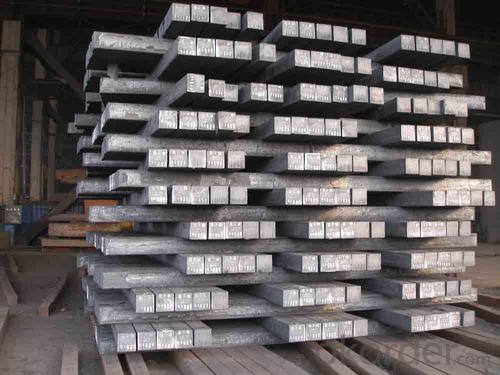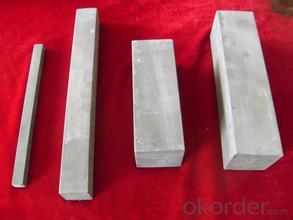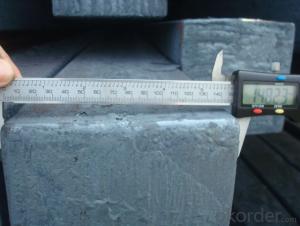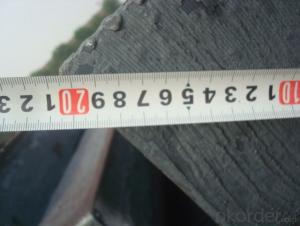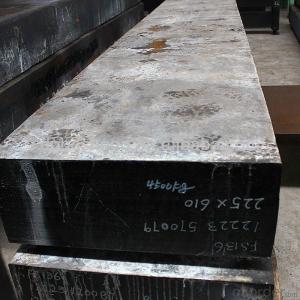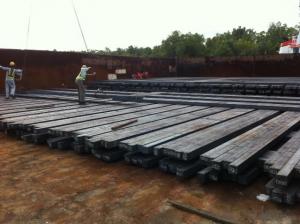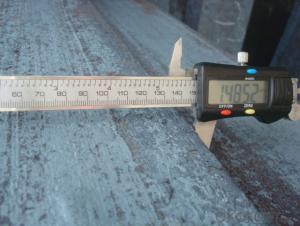Chinese Standard Billet Bar 12M
- Loading Port:
- China Main Port
- Payment Terms:
- TT or LC
- Min Order Qty:
- -
- Supply Capability:
- -
OKorder Service Pledge
OKorder Financial Service
You Might Also Like
Product Description:
OKorder is offering Chinese Standard Billet Bar 12M at great prices with worldwide shipping. Our supplier is a world-class manufacturer of steel, with our products utilized the world over. OKorder annually supplies products to European, North American and Asian markets. We provide quotations within 24 hours of receiving an inquiry and guarantee competitive prices.
Product Applications:
Chinese Standard Billet Bar 12M are ideal for structural applications and are widely used in the construction of buildings and bridges, and the manufacturing, petrochemical, and transportation industries.
Product Advantages:
OKorder's Chinese Standard Billet Bar 12M are durable, strong, and resist corrosion.
Main Product Features:
· Premium quality
· Prompt delivery & seaworthy packing (30 days after receiving deposit)
· Corrosion resistance
· Can be recycled and reused
· Mill test certification
· Professional Service
· Competitive pricing
Product Specifications:
Manufacture: Hot rolled
Grade: Q195 – 235
Certificates: ISO, SGS, BV, CIQ
Length: 6m – 12m, as per customer request
Packaging: Export packing, nude packing, bundled
Chinese Standard (H*W*T) | Weight (Kg/m) | 6m (pcs/ton) | Light I (H*W*T) | Weight (Kg/m) | 6m (pcs/ton) | Light II (H*W*T) | Weight (Kg/m) | 6M |
100*68*4.5 | 11.261 | 14.8 | 100*66*4.3 | 10.13 | 16.4 | 100*64*4 | 8.45 | 19.7 |
120*74*5.0 | 13.987 | 11.9 | 120*72*4.8 | 12.59 | 13.2 | 120*70*4.5 | 10.49 | 15.8 |
140*80*5.5 | 16.89 | 9.8 | 140*78*5.3 | 15.2 | 10.9 | 140*76*5 | 12.67 | 13.1 |
160*88*6 | 20.513 | 8.1 | 160*86*5.8 | 18.46 | 9 | 160*84*5.5 | 15.38 | 10.8 |
180*94*6.5 | 24.143 | 6.9 | 180*92*6.3 | 21.73 | 7.6 | 180*90*6 | 18.11 | 9.2 |
200*100*7 | 27.929 | 5.9 | 200*98*6.8 | 25.14 | 6.6 | 200*96*6.5 | 20.95 | 7.9 |
220*110*7.5 | 33.07 | 5 | 220*108*7.3 | 29.76 | 5.6 | 220*106*7 | 24.8 | 6.7 |
250*116*8 | 38.105 | 4.3 | 250*114*7.8 | 34.29 | 4.8 | 250*112*7.5 | 28.58 | 5.8 |
280*122*8.5 | 43.492 | 3.8 | 280*120*8.2 | 39.14 | 4.2 | 280*120*8 | 36.97 | 4.5 |
300*126*9 | 48.084 | 3.4 | 300*124*9.2 | 43.28 | 3.8 | 300*124*8.5 | 40.87 | 4 |
320*130*9.5 | 52.717 | 3.1 | 320*127*9.2 | 48.5 | 3.4 | |||
360*136*10 | 60.037 | 2.7 | 360*132*9.5 | 55.23 | 3 |
FAQ:
Q1: Why buy Materials & Equipment from OKorder.com?
A1: All products offered byOKorder.com are carefully selected from China's most reliable manufacturing enterprises. Through its ISO certifications, OKorder.com adheres to the highest standards and a commitment to supply chain safety and customer satisfaction.
Q2: How do we guarantee the quality of our products?
A2: We have established an advanced quality management system which conducts strict quality tests at every step, from raw materials to the final product. At the same time, we provide extensive follow-up service assurances as required.
Q3: How soon can we receive the product after purchase?
A3: Within three days of placing an order, we will begin production. The specific shipping date is dependent upon international and government factors, but is typically 7 to 10 workdays.
Q4: What makes stainless steel stainless?
A4: Stainless steel must contain at least 10.5 % chromium. It is this element that reacts with the oxygen in the air to form a complex chrome-oxide surface layer that is invisible but strong enough to prevent further oxygen from "staining" (rusting) the surface. Higher levels of chromium and the addition of other alloying elements such as nickel and molybdenum enhance this surface layer and improve the corrosion resistance of the stainless material.
Q5: Can stainless steel rust?
A5: Stainless does not "rust" as you think of regular steel rusting with a red oxide on the surface that flakes off. If you see red rust it is probably due to some iron particles that have contaminated the surface of the stainless steel and it is these iron particles that are rusting. Look at the source of the rusting and see if you can remove it from the surface.
Images:
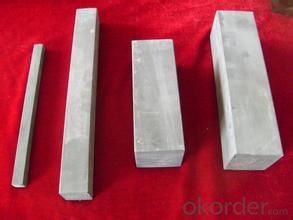
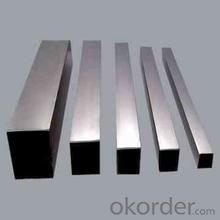
- Q: Can steel billets be used for marine applications?
- Yes, steel billets can be used for marine applications. Steel billets are commonly used in the construction of ships, offshore structures, and marine equipment due to their high strength, durability, and corrosion resistance properties. They provide the necessary strength to withstand the harsh marine environment and can be shaped and welded to meet specific design requirements.
- Q: How are steel billets used in the manufacturing of packaging materials?
- Steel billets are used in the manufacturing of packaging materials by being rolled into thin sheets to create metal containers or cans. These billets are first heated and then passed through a series of rolling machines to achieve the desired thickness. These sheets are further processed and shaped to form different types of packaging materials such as cans, boxes, or containers, which provide durability and strength to protect and preserve various products during transportation and storage.
- Q: What are the different production methods for steel billets?
- There are several different production methods for steel billets, each with its own unique characteristics and advantages. 1. Casting: One of the most common methods is the casting process, where molten steel is poured into a mold and allowed to solidify. This method can be further divided into continuous casting and ingot casting. Continuous casting involves the continuous pouring of molten steel into a water-cooled mold, which results in a continuous solidification process. Ingot casting, on the other hand, involves pouring molten steel into individual molds to create ingots that are then used as raw material for further processing. 2. Direct Reduction: Another method is the direct reduction process, which involves the reduction of iron ore in the presence of a reducing agent such as natural gas or coal. This process produces direct reduced iron (DRI), which can then be used to produce steel billets through subsequent melting and casting processes. 3. Electric Arc Furnace (EAF): The EAF method involves melting scrap steel in an electric arc furnace. This process is commonly used in recycling steel as it allows for the use of various scrap sources, including old cars, appliances, and industrial waste. The molten steel is then cast into billets or other desired shapes. 4. Basic Oxygen Furnace (BOF): The BOF method is a traditional steelmaking process that involves the conversion of molten iron from a blast furnace into steel through the injection of oxygen. This process is used for large-scale production of steel billets and offers high efficiency and flexibility in terms of raw material usage. 5. Powder Metallurgy: Powder metallurgy is an alternative method that involves compacting and sintering metal powders to create solid objects. In the case of steel billets, metal powders are compressed into the desired shape and then heated to a high temperature to achieve solidification. Each of these production methods has its own advantages and is suited for different applications and production scales. The choice of method depends on various factors including the desired properties of the steel, cost considerations, environmental impact, and availability of raw materials.
- Q: What is the role of steel billets in the construction of offshore platforms?
- The construction of offshore platforms heavily relies on steel billets, as they play an essential role in this process. Offshore platforms are enormous structures situated in the open sea, used for extracting oil or gas from beneath the ocean floor. Due to the demanding environmental conditions and the paramount importance of safety and durability, steel billets are extensively utilized in their construction. One of the key functions of steel billets is to serve as the primary material for fabricating different components of offshore platforms. Billets are large, semi-finished steel products typically employed as starting materials in the production of other steel products. They are cast into specific shapes, often square or rectangular, and possess a solid cross-section. Offshore platforms necessitate steel with exceptional strength, corrosion resistance, and impact toughness to withstand the challenging conditions they face, including strong waves, harsh weather, and extreme temperatures. Steel billets are frequently made from high-strength alloyed steels, providing superior mechanical properties and corrosion resistance. These billets are further processed to manufacture various structural elements of offshore platforms, such as beams, columns, braces, and other support structures. These components must have the ability to bear the weight of the platform itself, as well as endure the forces generated by ocean waves, wind, and the extraction process. Additionally, steel billets are also utilized in the production of pipes and tubes, which are crucial for transporting oil and gas from beneath the seabed to the platform or to the shore. These pipes must possess strength, durability, and corrosion resistance to ensure the secure and efficient flow of hydrocarbons. To summarize, steel billets act as the fundamental building blocks for constructing offshore platforms. They provide the raw material necessary for fabricating various structural components, guaranteeing the strength, durability, and safety of these massive structures in the challenging offshore environment.
- Q: What is the role of steel billets in the manufacturing of structural steel bridges?
- Steel billets play a crucial role in the manufacturing of structural steel bridges. These billets are essentially semi-finished products that serve as the raw material for the production of various steel products, including structural steel bridges. The process begins with steel billets being heated and then passed through a series of rolling mills to shape them into the desired form. This rolling process ensures that the billets are transformed into long, slender sections that can be utilized in the construction of bridges. Once the steel billets have been rolled into the appropriate shapes, they are then further processed and fabricated to create the necessary components for structural steel bridges. These components can include beams, columns, girders, and other critical elements that provide strength, stability, and load-bearing capabilities to the bridge structure. The use of steel billets in the manufacturing of structural steel bridges offers several advantages. Firstly, steel is known for its exceptional strength-to-weight ratio, making it an ideal material for constructing bridges that can withstand heavy loads while remaining relatively lightweight. The versatility of steel also allows for the creation of complex bridge designs, accommodating different architectural and engineering requirements. Additionally, steel billets are highly durable and resistant to environmental factors such as corrosion, which is crucial for ensuring the long-term integrity and safety of the bridge structure. This durability contributes to the overall longevity of the bridge, reducing maintenance and replacement costs over time. In summary, steel billets serve as the foundation for the production of structural steel bridges. Through the rolling and fabrication processes, these billets are transformed into the various components that make up the bridge structure, providing strength, stability, and durability. The use of steel billets enables the construction of bridges that can withstand heavy loads, remain lightweight, and withstand environmental factors, ensuring the long-term integrity and safety of the bridge.
- Q: Can steel billets be used for decorative purposes?
- Yes, steel billets can be used for decorative purposes. Steel billets are the raw material used for various applications in the steel industry, including the production of decorative products. By applying various techniques such as forging, casting, or machining, steel billets can be transformed into aesthetically pleasing decorative items such as sculptures, ornamental gates, furniture, architectural elements, and more. The versatility and durability of steel make it a popular choice for decorative purposes, as it can be shaped into intricate designs and withstand outdoor conditions. Additionally, steel can be further enhanced with various finishes, such as painting, powder coating, or patina, to enhance its visual appeal and complement different styles or aesthetics.
- Q: How are steel billets used in the production of wire rods?
- Steel billets are used in the production of wire rods as they serve as the initial semi-finished product that undergoes further processing. These billets are heated and then passed through a series of rolling mills, where they are transformed into wire rods of desired shapes and sizes. The rolling process helps to reduce the billet's cross-sectional area, elongate it, and improve its mechanical properties. Once the wire rods are produced, they can be further processed or used directly in various industries, such as construction, automotive, and manufacturing.
- Q: What are the different types of non-destructive testing methods used for steel billets?
- There are several different types of non-destructive testing methods used for steel billets. These methods are employed to ensure the quality and integrity of the billets without causing any damage or alteration to the material. Some of the commonly used non-destructive testing methods for steel billets include: 1. Ultrasonic Testing (UT): This method uses high-frequency sound waves to detect internal defects or inconsistencies within the steel billets. UT can identify issues like cracks, voids, and inclusions that may affect the billet's strength and performance. 2. Magnetic Particle Testing (MPT): MPT involves the use of magnetic fields and magnetic particles to detect surface and near-surface defects in the steel billets. This method is particularly effective for identifying cracks, seams, and other discontinuities that may not be visible to the naked eye. 3. Eddy Current Testing (ECT): ECT utilizes electromagnetic induction to assess the quality of steel billets. It can detect surface and near-surface defects, such as cracks and corrosion, by measuring changes in electrical conductivity and magnetic fields. 4. Visual Inspection: Visual inspection is a basic non-destructive testing method that involves a thorough visual examination of the steel billets. It aims to identify any visible defects, such as surface cracks, dents, or irregularities in shape or size. 5. Penetrant Testing (PT): PT involves applying a liquid or fluorescent dye to the surface of the steel billets. The dye seeps into any surface defects, and after a certain time, excess dye is removed, and a developer is applied to make the defects visible. This method is useful for detecting surface cracks, porosity, and other surface irregularities. 6. Radiographic Testing (RT): RT uses X-rays or gamma rays to penetrate the steel billets and produce an image that can reveal internal defects. This method is highly effective for detecting cracks, inclusions, and voids within the billets. Each of these non-destructive testing methods plays a crucial role in ensuring the quality and reliability of steel billets. By employing a combination of these techniques, manufacturers can identify any potential defects or inconsistencies and take appropriate measures to rectify them, thereby ensuring the safety and performance of the steel billets in various applications.
- Q: How are steel billets used in the manufacturing of automotive components?
- Steel billets are used in the manufacturing of automotive components as the starting material for various forging and machining processes. These billets are heated, shaped, and then further processed to create different automotive parts like crankshafts, connecting rods, gears, and axles. The high strength and durability of steel make it an ideal choice for these critical components, ensuring the safety and performance of vehicles.
- Q: How are steel billets used in the production of power generation equipment?
- Steel billets are used in the production of power generation equipment due to their strength, durability, and versatility. Power generation equipment, such as turbines and generators, require sturdy and reliable components to withstand the harsh operating conditions and provide uninterrupted power supply. Steel billets, which are small, semi-finished steel products, serve as the raw material for manufacturing various parts of power generation equipment. They are typically melted down and cast into specific shapes to create components such as turbine blades, shafts, casings, and rotors. The use of steel billets in power generation equipment ensures high structural integrity, as steel is known for its excellent mechanical properties. It possesses high tensile strength, allowing it to withstand the extreme rotational forces and pressures experienced within turbines and generators. Additionally, steel exhibits good resistance to corrosion and high temperatures, making it ideal for use in power generation equipment that operates in harsh environments. Furthermore, steel billets can be easily machined and welded, allowing for precise manufacturing and assembly of complex parts. This flexibility in shaping and joining steel billets enables the production of customized components tailored to the specific requirements of power generation equipment. In summary, steel billets play a crucial role in the production of power generation equipment by providing a strong, durable, and versatile material for creating various components. Their use ensures the reliability and longevity of power generation equipment, allowing for efficient and uninterrupted power generation.
Send your message to us
Chinese Standard Billet Bar 12M
- Loading Port:
- China Main Port
- Payment Terms:
- TT or LC
- Min Order Qty:
- -
- Supply Capability:
- -
OKorder Service Pledge
OKorder Financial Service
Similar products
Hot products
Hot Searches
Related keywords


